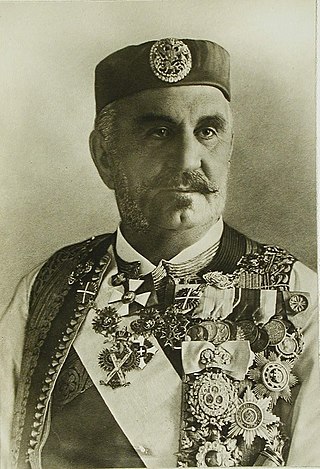Related Research Articles

Petar I Petrović-Njegoš was the Prince-Bishop of Montenegro from 1784 to 1830 and Exarch (legate) of the Serbian Orthodox Church in Montenegro. He was the most popular spiritual and military leader from the Petrović dynasty. During his long rule, Petar strengthened the state by uniting the often quarreling tribes, consolidating his control over Montenegrin lands, introducing the first laws in Montenegro in 1798. His rule prepared Montenegro for the subsequent introduction of modern institutions of the state: taxes, schools and larger commercial enterprises. He was canonized by the Serbian Orthodox Church as Saint Peter of Cetinje.

Nikola I Petrović-Njegoš was the last monarch of Montenegro from 1860 to 1918, reigning as prince from 1860 to 1910 and as the country's first and only king from 1910 to 1918. His grandsons were kings Alexander I of Yugoslavia and Umberto II of Italy among others.

Danilo I Petrović-Njegoš was the Metropolitan of Cetinje between 1697 and 1735, and the founder of the House of Petrović-Njegoš, which ruled Montenegro from 1697 to 1918.
Gjon I Kastrioti, commonly known as Gjon Kastrioti was an Albanian feudal lord from the House of Kastrioti and the father of Albanian leader Gjergj Kastrioti. He governed the territory between the Cape of Rodon and Dibër and had at his disposal an army of 2,000 horsemen.
Tadić is a Croatian and Serbian surname, a patronymic and diminutive of the masculine given name Tadija. It may refer to:

Banjani was a tribe of Vlach origin in Old Herzegovina, and historical region in western Montenegro. Its territory comprises 380 km2 (150 sq mi), west of Nikšić, in the centre between Nikšić and Bileća, from the top of Njegoš mountain to the Trebišnjica river, and on to the Bileća Lake. All Banjani families have Jovanjdan as their slava.

Montenegro–Russia relations are foreign relations between Montenegro and Russia. Montenegro has an embassy in Moscow and Russia has an embassy in Podgorica.
The Battle of Krusi was fought on 22 September 1796 between the campaigning army of Ottoman Empire commanded by Kara Mahmud Pasha, the Pasha of Scutari, and tribes of Prince-Bishopric of Montenegro under the command of Metropolitan Petar I Petrović Njegoš and Jovan Radonjić, at Krusi, Lješanska nahija.
Staniša Radonjić, known as Staniša Popov, was a Serbian Orthodox priest, chieftain (vojvoda) of the Njeguši tribe, and Serdar of the Prince-Bishopric of Montenegro.

The Prince-Bishopric of Montenegro was a Serbian Orthodox ecclesiastical principality that existed from 1516 until 1852. The principality was located around modern-day Montenegro. It emerged from the Eparchy of Cetinje, later known as the Metropolitanate of Montenegro and the Littoral, whose bishops defied the Ottoman Empire overlordship and transformed the parish of Cetinje into a de facto theocracy, ruling it as Metropolitans.

Ipokrat "Vladan" Đorđević was a Serbian politician, diplomat, physician, prolific writer, and organizer of the State Sanitary Service. He held the post of mayor of Belgrade, Minister of Education, Prime Minister of Serbia, Minister of Foreign Affairs and Envoy to Athens and Istanbul.

Ivan Božić was a Yugoslavian historian and academic. He was expert in history of medieval Zeta and the Venetian Republic's policy toward its coastal areas.
The Montenegrin nobility (1852–1918) are notable people of the Principality of Montenegro and the Kingdom of Montenegro who hold titles such as Veliki Vojvoda, Knez (Prince), Vojvoda (Duke), Serdar (Count), and Guvernadur (Governor). The titles are hereditary or personal. Focusing on the Montenegrin nobility of the late 19th century surrounding the then recent secularization of the Principality under Danilo II and his court, excluding the older traditional clan nobility.
The House of Paltašić was a late Medieval noble family from Kotor, modern-day Montenegro.
The Lim-Sandžak Chetnik Detachment was a military unit of collaborationist Chetniks that was established in northern Montenegro and Sandžak at the end of June 1942, during World War II. In August 1942, it was commanded by Pavle Đurišić, and was the largest and the most elite military unit of Draža Mihailović at that time.
Jovan Albanez or Ivan Albanez c. 1732) was a military officer of Montenegrin Serb origin who led the first group of colonists from the Military Frontier of the Habsburg monarchy to the Russian Empire in the first half of the 18th century.
The Battle on Vrtijeljka was fought on the hill of Vrtijeljka near Cetinje between a Venetian irregular force and an advancing Ottoman force on 7 May 1685 at the start of the Morean War. The Venetian force was made up of fighters from the neighbouring areas, including the band of acclaimed hajduk Bajo Pivljanin, and several Christian tribes. The large Ottoman force was led by sanjak-bey Süleyman of Scutari.
Grujica Žeravica was a Serb hajduk commander active in the Ottoman territories of Herzegovina and southern Dalmatia during the Venetian–Ottoman war (1645–69). The hajduks, Ottoman subjects, crossed into Venetian territory from where they "jumped into" Ottoman territory. These guerilla forces closely cooperated and were recruited by the Republic of Venice to defend the Venetian–Ottoman frontier during the war. He was a comrade of acclaimed Bajo Pivljanin.
Serbian question refers to several periods in Serbian history and diplomatic history.
References
- ↑ Király, Béla K.; Rothenberg, Gunther Erich (1982). War and Society in East Central Europe: East Central European Society and War in the Pre-Revolutionary Eighteenth Century. ISBN 9780930888190.
- ↑ Đorđević 1912, p. 35.
- ↑ Istorijski institut SR Crne Gore 1951, p. 277.
- ↑ SANU (1971). Glas. Vol. 280–281. Naučno delo; SANU. p. 253.
- ↑ Popović 1994, p. 17.
- 1 2 Лещиловская 2006, p. 49.